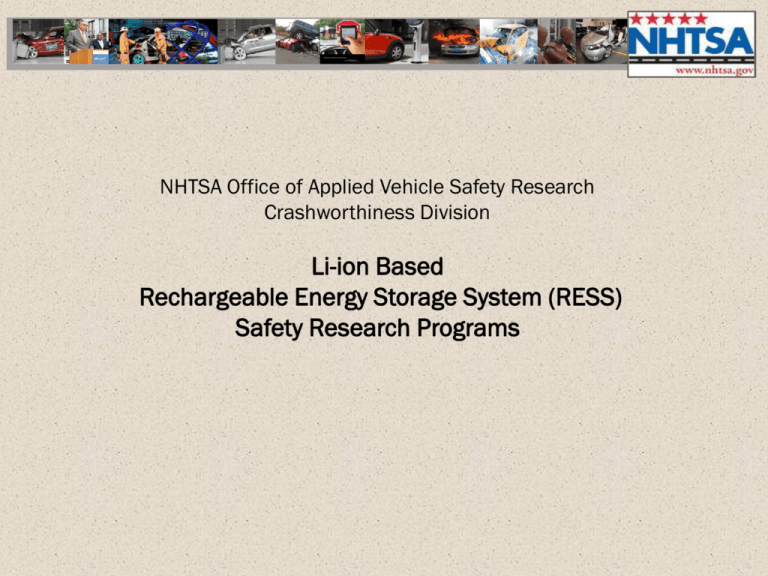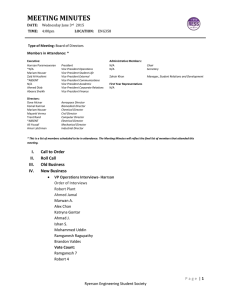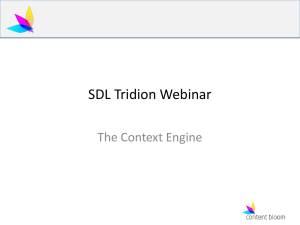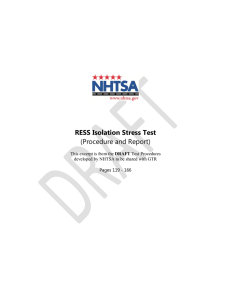Li-ion Based Rechargeable Energy Storage System (RESS)
advertisement

NHTSA Office of Applied Vehicle Safety Research Crashworthiness Division Li-ion Based Rechargeable Energy Storage System (RESS) Safety Research Programs RESS Research Program Projects & Process Flow Failure Modes and Effects Analysis (FMEA) Test Procedures Development Analytical Methods for Control System Safety Performance Diagnostics, Prognostics, and Operator Indicators/Messages Data Generation (with Sandia National Labs) Inoperative Vehicle RESS Diagnostics and Common/Standardized Discharge Process(s) Control System Functional Safety Comparable Safety Metrics with Data for Li-ion RESS NHTSA Policy and Rulemaking Failure Modes and Effects Analysis An FMEA is an analytical tool which identifies, lists, and ranks all potential failures and their corresponding effects of the product or process under investigation, in this case Liion based RESS Safety Performance Battelle Memorial Institute, Columbus, OH The results of this FMEA will be used to perform a gap analysis to existing standards and test procedures for thoroughness. … (including the Test Procedure Development work plans, Diagnostics and Discharge Process Development, and Control System Safety of the NHTSA research program). Draft Report Under Further Development First quarter 2013 • Industry Review and Feedback Becomes Living Document for Other Safety Analysis Test Procedure Development Develop and document repeatable vehicle level safety performance tests procedures. • Addressing critical potential failure modes • Addressing all areas of operation Including: Charging, Normal Operation, Crash, and Post-Crash • Building upon the body of existing standards (SAE J2464, SAE J2929, ECE R100, Etc.) Data generated from these test procedures will be used to accurately measure the effects of the failure modes generated by both normal and abnormal abuse conditions. • Repeatable, Quantifiable, Comparable, Directly associated to safety risks for accurate analysis 2 Contract Awards: October 2011 – October 2013 Independent testing at Sandia National Labs through January 2014 SAE International RESS Research Program Safety Performance of Rechargeable Energy Storage Systems (RESS) Project Objectives: • Develop Li-Ion RESS Safety Test Methods: • Vehicle level testing when possible • Component level testing when necessary • With and without loss of the control system • Identify and Document: • Test Conditions • Boundary Limitations • Performance Criteria • Develop Performance Based Safety Metrics SAE International RESS Research Program Test scope and conditions will include consideration of the following but, are not limited to: RESS enclosure integrity Electrical abuse & short circuits Electrical isolation Thermal Humidity Altitude Submergence Single and multi-level failure modes Charging states (including overcharge) Capacities and operational states Fire or flame Thermal runaway or propagation Corrosion Storage / shipping Shock / drop Mounting / retention Vibration / fatigue Impact / penetration / crush Post crash environments Vapor / venting / emissions Leakage of hazardous substances Explosion Flow reversal Aging EMC/EMI and ESD effects Dielectric strength SAE International RESS Research Program RESS ancillary subsystem components to be considered for incorporation in the testing plan include: Onboard Chargers, Invertors and Convertors Monitoring & Control Interfaces Protective Devices Control Systems and Interface Charging Inlet Wiring and Connectors Voltage Interlocks & Disconnects Power Connection Interfaces Thermal Management Systems RESS Packs, Modules & Cells Serial Data Communication Bus SAE International RESS Research Program Project Timeline: Single Level Failure Mode Dual Level Failure Mode Phase 1 – Develop Test Procedures Oct 01, 2012 – June, 30 2012 July 01, 2012 – Nov 30, 2012 Phase 2 – Conduct Testing at OEM Labs July 01, 2012 – Nov 30, 2012 Dec 01, 2012 – Mar 31, 2013 Phase 3 – Refine Procedures & Conduct Verification Tests Oct 01, 2012 – Mar 31, 2013 Feb 01, 2013 – Jun 30, 2013 Phase 4 – Final Refinement & Documentation Apr 01, 2013 – Aug 31, 2013 Apr 01, 2013 – Aug 31, 2013 * Project Completion Sept. 30, 2013 SAE International RESS Research Program System FMEA Development Phase 1 Methodology - Draft, Preliminary Test Procedures: Recognized Failure Modes Global Standards Review & Gap Analysis Test Methodology Development Test Standards Development Test Assignment Matrix Phase 2 – OEM Testing SAE International RESS Research Program OEM Laboratory Phase 2 - Single Level Failure Mode Tests 07/01/12 to 11/30/12 1. 2. 3. 4. 5. 6. 7. 8. 9. 10. 11. Vibration: Pack Test Thermal Shock: Pack Test External Short Circuit Protection: Pack Test Overcharge Protection: Vehicle Test Over Discharge Protection: Vehicle Test Over Temperature Protection: Vehicle Test Under Temperature Protection: Vehicle Test Fire Resistance – Short Duration: Pack Test Fire Resistance – Long Duration: Pack Level Vehicle Crash Evaluations: Vehicle Test Water Intrusion Test: Vehicle Test SAE International RESS Research Program Independent Laboratory Phase 2: Cell Level Abuse Tests 09/01/12 to 12/31/12 Cell Resilience to Thermal Propagation Test Description: Data to be Collected: • Steel Nail Penetration • Cell Surface Temperature(s) • Ceramic Nail with Ni Contaminant • Air Temperature • Ceramic Nail Penetration • Cell Voltage • Crush • Impact • Forced Internal Short Circuit of Cells • Current (if applicable) • Heat Output • Video • Video Thermal Imaging • Vent Gas Analysis SAE International RESS Research Program Dual Level Failure Mode Potential 1st Level Causes Which May Result in Overcharge: • Power related causes • Communications related causes Assessment Parameters: • "Tell-Tale" detection capability? • Diagnostic code generated? • Voltage Sensor related causes • Can the vehicle be charged in this present state fault? • Voltage detector circuit (ECU) related causes • Is charging allowed during Regen • Main contactor “Driver Circuit ON" failure • Welded contactors • Battery management system fails to initiate "charge stop" signal • Power control/ on-board charger module does not respond to "charge-stop" signal • Single cell overcharge resulting from imbalance • Failure of current sensors • Failure of self check Functional Safety Tools • Hazard Analysis & Fail Safe Strategies • Diagnostic Strategies and Trouble Codes • Software Strategies and Validation Requirements • Hardware and System Reliability • Validation Ford RESS Research Program • Test development program • Fault Tree Analysis • Standards review and gap analysis • Test procedure development • In-house testing and analysis • Test performance measures • External testing at Sandia National Labs • Test procedure refinement and documentation • Project Completion October 2013 • Additional Sandia Testing through January 2014 Standardized Battery Assessment, and Field Discharge Procedure NHTSA and Argonne National labs are working to identify, develop, and demonstrate methods for the safe management and handling of RESS in post-crash and nonoperational environments. Areas of Focus: • Definition of common interface connector and location to support • Diagnostic interface • Diagnostic protocol • Architectural requirements • Standardized Discharge Port/Terminal Project Timing : • October 2012 – August 2014 • Detailed research plan and timing are currently under development Analytical Tools Development Control System Performance Modeling Scope: Define required operator warning indicators for RESS safety critical criteria. Research prognostic conditions and warnings for for anticipated safety critical events. Volpe National Transportation Research Center is leading this effort to: • Establish basic Fail-Safe Conditions, Diagnostic Codes and indicators, Data Recording/Storage (e.g., EDR), and Safety Prognostic Requirements • Utilize outputs from FMEA and Discharge projects • Timing: October 2012 – March 2014 • Detailed research plan, timeline and deliverables expected January 2013 Cycling Testing to Evaluate Battery Health Test procedure development for post-crash health and safety performance GM and SAE have teamed with Sandia National Labs Adapt USABC function cycle test for use in post crash assessment of batteries Recently initiated, timeline and test plans are under development Questions? Thank you








